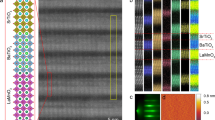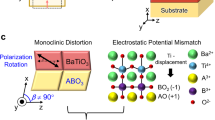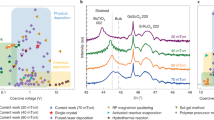Abstract
Epitaxial growth of SrTiO3 on silicon by molecular beam epitaxy has opened up the route to the integration of functional complex oxides on a silicon platform. Chief among them is ferroelectric functionality using perovskite oxides such as BaTiO3. However, it has remained a challenge to achieve ferroelectricity in epitaxial BaTiO3 films with a polarization pointing perpendicular to the silicon substrate without a conducting bottom electrode. Here, we demonstrate ferroelectricity in such stacks. Synchrotron X-ray diffraction and high-resolution scanning transmission electron microscopy reveal the presence of crystalline domains with the long axis of the tetragonal structure oriented perpendicular to the substrate. Using piezoforce microscopy, polar domains can be written and read and are reversibly switched with a phase change of 180°. Open, saturated hysteresis loops are recorded. Thus, ferroelectric switching of 8- to 40-nm-thick BaTiO3 films in metal–ferroelectric–semiconductor structures is realized, and field-effect devices using this epitaxial oxide stack can be envisaged.
This is a preview of subscription content, access via your institution
Access options
Subscribe to this journal
Receive 12 print issues and online access
$259.00 per year
only $21.58 per issue
Buy this article
- Purchase on Springer Link
- Instant access to full article PDF
Prices may be subject to local taxes which are calculated during checkout






Similar content being viewed by others
Change history
08 October 2013
In the version of this Article originally published, the scale bars in Fig. 3 were incorrectly sized. This has now been corrected in the HTML and PDF versions.
References
Mc Kee, R. A., Walker, F. J. & Chisholm, M. F. Crystalline oxides on silicon: the first five monolayers. Phys. Rev. Lett. 81, 3014–3017 (1998).
Reiner, J. W. et al. Crystalline oxides on silicon. Adv. Mater. 22, 2919–2938 (2010).
Scott, J. F. in Ferroelectric Memories Ch. 2,12 (Springer, 2000).
Salahuddin, S. & Datta, S. Use of negative capacitance to provide voltage amplification for low power nanoscale devices. Nano Lett. 8, 405–410 (2008).
Zhirnov, V. V. & Cavin, R. K. Negative capacitance to the rescue? Nature Nanotech. 3, 77–78 (2008).
Rusu, A., Salvatore, G. A., Jimenez, D. & Ionescu, A. M. Metal–ferroelectric–metal–oxide–semiconductor field effect transistor with sub-60 mV/decade subthreshold swing and internal voltage amplification. Proc. IEDM 16.3.1–16.3.4 (2010).
Batra, I. P., Wurfel, P. & Silverman, B. D. Depolarization field and stability considerations in thin ferroelectric films. J. Vac. Sci. Technol. 10, 687–692 (1973).
Batra, I. P., Wurfel, P. & Silverman, B. D. Phase transition, stability and depolarization field in ferroelectric thin films. Phys. Rev. B 8, 3257 (1973).
Ito, D., Fujimura, N., Yoshimura, T. & Ito, T. Ferroelectric properties of YMnO3 epitaxial films for ferroelectric-gate field-effect transistors. J. Appl. Phys. 93, 5563–5567 (2003).
Khan, A. I. et al. Experimental evidence of ferroelectric negative capacitance in nanoscale heterostructures. Appl. Phys. Lett. 99, 113501 (2011).
Vaithyanathan, V. et al. c-Axis oriented epitaxial BaTiO3 films on (001)Si. J. Appl. Phys. 100, 024108 (2006).
Niu, F. & Wessels, B. W. Epitaxial growth and strain relaxation of BaTiO3 thin films on SrTiO3 buffered (001) Si by molecular beam epitaxy. J. Vac. Sci. Technol. B 25, 1053–1057 (2007).
Niu, G. et al. Epitaxy of BaTiO3 thin film on Si(001) using a SrTiO3 buffer layer for non-volatile memory application. Microelectron. Eng. 88, 1232–1235 (2011).
Hytch, M. J., Snoeck, E. & Kilaas, R. Quantitative measurement of displacement and strain fields from HREM micrographs. Ultramicroscopy 74, 131–146 (1998).
Rouvière, J. L. & Sarigiannidou, E. Theoretical discussions on the geometrical phase analysis. Ultramicroscopy 106, 1–17 (2005).
Jia, C-L. et al. Unit-cell scale mappping of ferroelectricity and tetragonality in epitaxial ultrathin ferroelectric films. Nature Mater. 6, 64–69 (2007).
Kolpak, A. M. et al. Interface-induced polarization and inhibition of ferroelectricity in epitaxial SrTiO3/Si. Phys. Rev. Lett. 105, 217601 (2010).
Gruverman, A. & Kholkin, A. Nanoscale ferroelectrics: processing, characterization and future trends. Rep. Prog. Phys. 69, 2443–2474 (2006).
Balke, N., Bdikin, I., Kalinin, S. V. & Kholkin, A. L. Electromechanical imaging and spectroscopy of ferroelectric and piezoelectric materials: state of the art and prospects for the future. J. Am. Ceram. Soc. 92, 1629–1647 (2009).
Kalinin, S. V., Rar, A. & Jesse, S. A decade of piezoresponse force microscopy: progress, challenges, and opportunities. IEEE Trans. Ultrason. Ferroelec. Freq. Control 53, 2226–2252 (2006).
Junquera, J. & Ghosez, P. Critical thickness for ferroelectricity in perovskite ultrathin films. Nature 422, 506–509 (2003).
Sai, N., Kolpak, M. & Rappe, A. M. Ferroelectricity in ultrathin peorvskite films. Phys. Rev. B 72, 020101 (R) (2005).
Kim, D. J. et al. Polarization relaxation induced by a depolarization field in ultrathin ferroelectric BaTiO3 capacitors. Phys. Rev. Lett. 95, 237602 (2005).
Paul, J., Nishimatsu, T., Kawazoe, Y. & Waghmare, U. V. Ferroelectric phase transitions in ultrathin films of BaTiO3 . Phys. Rev. Lett. 99, 077601 (2007).
Garcia, V. et al. Giant tunnel electroresistance for non-destructive readout of ferroelectric states. Nature 460, 81–84 (2009).
Cross, L. E. Flexoelectric effects: charge separation in insulating solids subjected to elastic strain gradients. J. Mater. Sci. 41, 53–63 (2006).
Garcia, R., Martinez, R. V. & Martinez, J. Nano-chemistry and scanning probe nanolithographies. Chem. Soc. Rev. 35, 29–38 (2006).
Bratkovsky, A. M. & Levanyuk, A. P. Depolarizing field and ‘real’ hysteresis loops in nanometer-scale ferroelectric films. Appl. Phys. Lett. 89, 253108 (2006).
Alexe, M., Harnagea, C., Hesse, D. & Gösele, U. Polarization imprint and size effects in mesoscopic ferroelectric structures. Appl. Phys. Lett. 79, 242–244 (2001).
Lu, H. et al. Enhancement of ferroelectric polarization stability by interface engineering. Adv. Mater. 24, 1209–1216 (2012).
Streiffer, S. K. et al. Observation of nanoscale 180° stripe domains in ferroelectric PbTiO3 thin films. Phys. Rev. Lett. 89, 067601 (2002).
Fong, D. D. et al. Ferroelectricity in ultrathin perovskite films. Science 304, 1650–1653 (2004).
Tenne, D. A. et al. Ferroelectricity in ultrathin BaTiO3 films: probing the size effect by ultraviolet Raman spectroscopy. Phys. Rev. Lett. 103, 177601 (2009).
Jia, C-L. et al. Atomic-scale study of electric dipoles near charged and uncharged domain walls in ferroelectric films. Nature Mater. 7, 57–61 (2008).
Zubko, P. et al. Electrostatic coupling and local structural distortions at interfaces in ferroelectric/paraelectric superlattices. Nano Lett. 12, 2846–2851 (2012).
Wei, Y. et al. Mechanism of cleaning Si(100) surface using Sr or SrO for the growth of crystalline SrTiO3 films. J. Vac. Sci. Technol. B 20, 1402–1405 (2002).
Choi M. et al. Strain relaxation in single crystal SrTiO3 grown on Si (001) by molecular beam epitaxy. J. Appl. Phys. 111, 064112 (2012).
Jesse, S., Kalinin, S. V., Proksch, R., Baddorf, A. P. & Rodriguez, B. J. The band excitation method in scanning probe microscopy for rapid mapping of energy dissipation on the nanoscale. Nanotechnology 18, 435503 (2007).
Jesse, S. & Kalinin, S. V. Band excitation in scanning probe microscopy: sines of change. J. Phys. D 44, 464006 (2011).
Jesse, S., Lee, H. N. & Kalinin, S. V. Quantitative mapping of switching behavior in piezoresponse force microscopy. Rev. Sci. Instrum. 77, 073702–073711 (2006).
Acknowledgements
C.D. acknowledges IBM for her Visiting Scientist position and CNRS for her detachment. Use of the National Synchrotron Light Source, Brookhaven National Laboratory, was supported by the US Department of Energy, Office of Science, Office of Basic Energy Sciences (contract no. DE-AC02-98CH10886). PFM experiments (T.M.A. and S.V.K.) were performed at the Center for Nanophase Materials Sciences at Oak Ridge National Laboratory, which is sponsored by the Scientific User Facility Division, Office of Basic Energy Sciences, US Department of Energy. The work in Austin was supported by the National Science Foundation (grant no. DMR-0548182) and the Office of Naval Research (grant no. N000 14-10-1-0489).
Author information
Authors and Affiliations
Contributions
C.D., M.M.F. and V.N. devised, designed and organized the work. A.P. and A.D designed and performed the work related to the growth of the samples. T.M.A. and S.V.K. designed and performed the PFM experiments and analysed the PFM data. C.D. and J.J.S. performed the X-ray diffraction experiments and analysed the data. C.D. and E.C. performed the electrical measurements and analysed the data. J.B. performed the TEM experiments and analysed the data by geometrical phase analysis. C.D. contributed to the GPA analysis. All authors contributed to the interpretation of the data and to the discussions.
Corresponding authors
Ethics declarations
Competing interests
The authors declare no competing financial interests.
Supplementary information
Supplementary information
Supplementary Information (PDF 513 kb)
Rights and permissions
About this article
Cite this article
Dubourdieu, C., Bruley, J., Arruda, T. et al. Switching of ferroelectric polarization in epitaxial BaTiO3 films on silicon without a conducting bottom electrode. Nature Nanotech 8, 748–754 (2013). https://doi.org/10.1038/nnano.2013.192
Received:
Accepted:
Published:
Issue Date:
DOI: https://doi.org/10.1038/nnano.2013.192
This article is cited by
-
Absence of critical thickness for polar skyrmions with breaking the Kittel’s law
Nature Communications (2023)
-
Record high room temperature resistance switching in ferroelectric-gated Mott transistors unlocked by interfacial charge engineering
Nature Communications (2023)
-
The effect of bottom electrode on structure and electrical properties of BaZr0.15Ti0.85O3 films on SrTiO3 substrates
Journal of Materials Science: Materials in Electronics (2023)
-
Enabling ultra-low-voltage switching in BaTiO3
Nature Materials (2022)
-
Highly heterogeneous epitaxy of flexoelectric BaTiO3-δ membrane on Ge
Nature Communications (2022)



